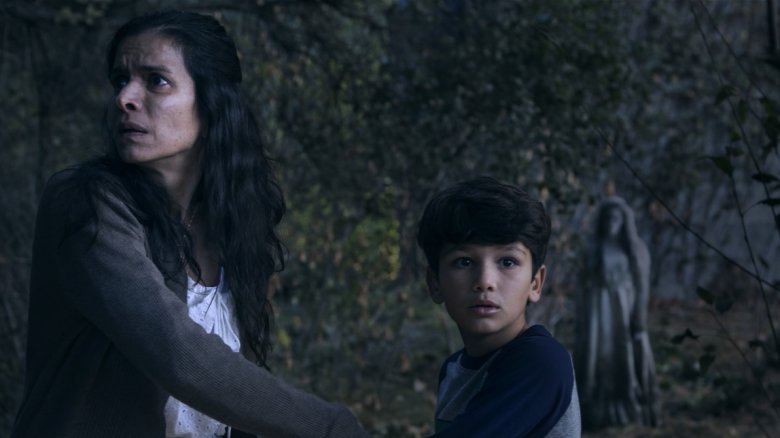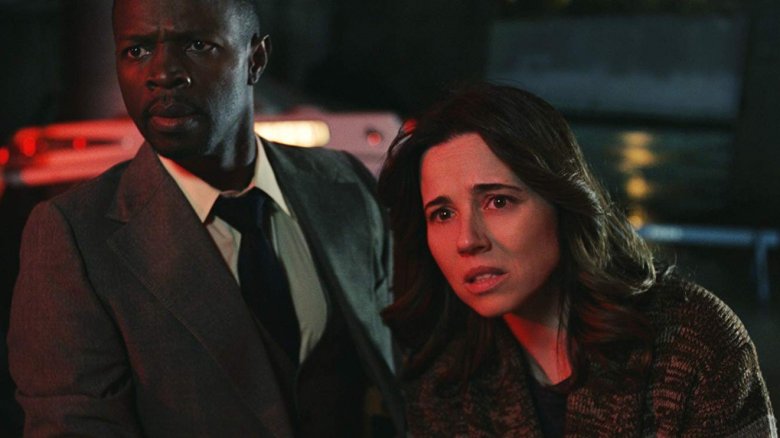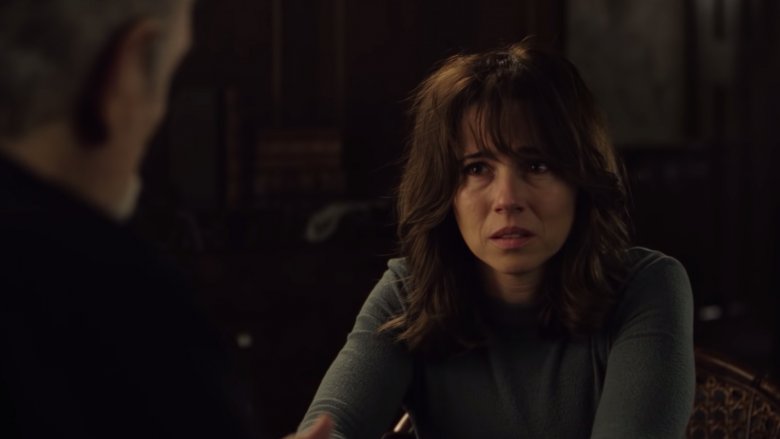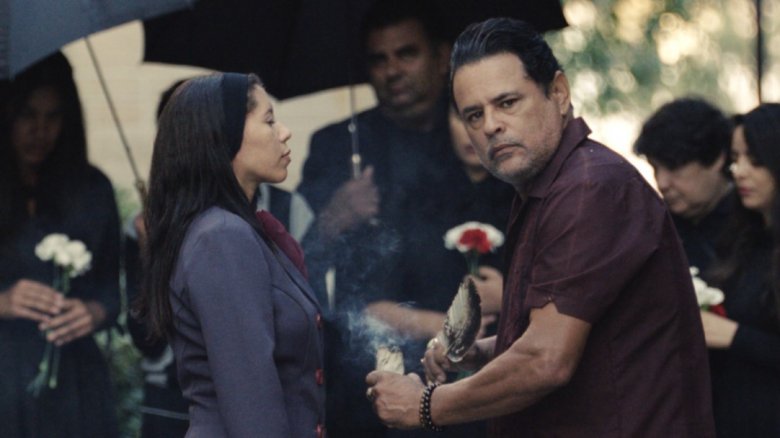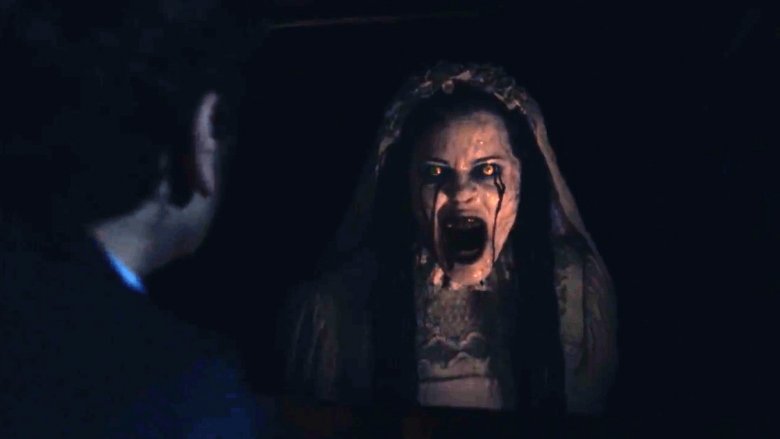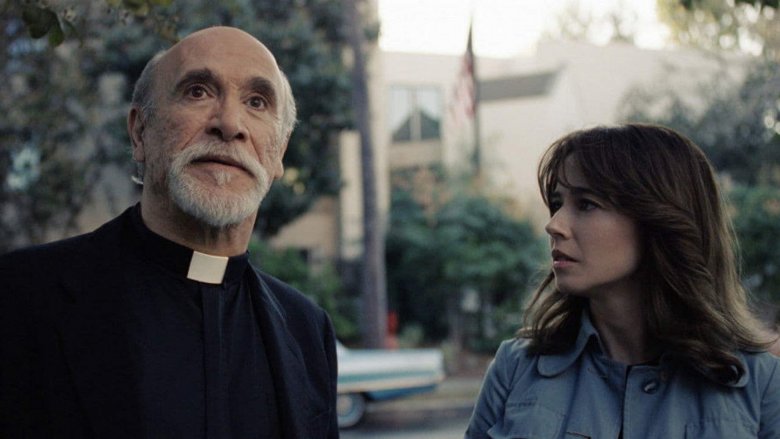The Curse Of La Llorona Ending Explained
The Curse of La Llorona marks the sixth entry in the Conjuring cinematic universe produced by James Wan. The paranormal horror film, helmed by debuting director Michael Chaves, is a spinoff from the main story as well as a taste of things to come — Chaves told the audience during a Q&A session after the film's screening at the South by Southwest film festival that he'll also be directing The Conjuring 3.
The film has earned negative reviews from Rotten Tomatoes-approved critics, making it one of the worst-reviewed films set in the Conjuring universe (alongside Annabelle and The Nun). It's unfortunate, because there's a truly scary story in here — in the real world, the story of La Llorona has been told to countless children to scare them out of misbehaving. Members of the La Llorona cast have recalled growing up with the fear that La Llorona would take them away from their families and drown them for bad behavior.
For those trying to understand the generations-old folklore and the film's place in the Conjuring universe, we're breaking down the final act of this latest entry. Here's the ending of The Curse of La Llorona explained.
The curse unfolds
Anna Garcia (Linda Cardellini), a widowed mother of two, is a CPS worker who struggles to juggle her personal and professional life. Things become more difficult for Anna after she gets mixed up in a strange case involving two children and a seemingly unstable mother. She finds the children in a closet — battered, scared, and confused — and after their mother attacks Anna, they're removed from their mother's custody. But the case isn't as clear-cut as it seems: Shortly after the children are placed in temporary housing, they're drowned in a nearby river.
The grieving mother blames Anna for her children's death, saying that by intervening, Anna allowed the evil spirit La Llorona to abduct and kill them. Unfortunately for Anna, the spirit latches onto her own two children, resulting in a haunting that leaves the family in a desperate situation.
Help comes in the form of Rafael Olvera (Raymond Cruz), an ex-priest with the skills necessary to banish La Llorona. After many close calls with the mournful spirit, La Llorona is finally vanquished when Anna stabs her through the heart with a specially made cross. Rafael leaves the family as they return to their home, finally free of the vengeful spirit's presence.
A mother in search of salvation
As La Llorona begins to target and prey on Anna's children, she must come to terms with the dangers facing her family. She seeks out the help of the church, but discovers that in order for help to arrive in time to save her children, she may have to place the safety of her family in the hands of a faith healer. In passing, Anna mentions that she isn't very religious. In response, Anna is told that she doesn't have to be religious to have faith — which is what she'll really need to beat La Llorona.
In an interview with Syfy, Linda Cardellini commented on Anna's character growth, stating that Anna learns the ability to overcome a difficult situation doesn't always come from a place of reason or rationality. Instead, it can come from "Generations of legend and passing down, and relying on others, and sort of fate. She has to search within herself and have some kind of faith."
While the film attempts to discuss Anna's faith and her need to embrace it, Anna doesn't go through much of a change from start to finish. Anna's character at no point uses faith as a tool against La Llorona, nor does she actually discuss any change in beliefs that would influence her character.
The faith-healing shaman
Once Anna is certain that she and her family are in grave danger, the faith healer and shaman, Rafael, becomes a key component in fighting against La Llorona. After leaving the priesthood, Rafael turned to alternative, more naturalistic ways of healing and helping people. His supplies are not communion wafers and wine but tinctures and jars of mysterious substances. Despite shifting to more mystic means of dealing with dark spirits, Rafael never lost his faith, keeping with the film's ideology of embracing belief to conquer evil.
When Rafael decides to help Anna defeat La Llorona, he initially tells her children that he feels no fear facing the evil spirit. However, after La Llorona is finally defeated, he's able to admit to feeling scared during the ordeal. While Rafael does show a bit of vulnerability in the end, the impact of this change is extremely minor and short-lived. After admitting to feeling fear, he minimizes it, saying, "Not really." His response makes it questionable whether his character underwent any actual growth — Rafael remains relatively the same throughout the film, and the events that transpire don't appear to have altered him in any major way.
Though Rafael offers some perspective on La Llorona and helps to vanquish her, his potential as a unique and possibly interesting character is left mostly unexplored due to the his late arrival, quick departure, and lack of emotional accessibility.
The legend of La Llorona
The tale of La Llorona, otherwise known as "The Weeping Woman," is rooted in Mexican folklore. Though the origin of the story isn't entirely certain, and different versions exist, the general idea is the same across the board. In an interview with AMC, Michael Chaves noted, "La Llorona was once human, and hers is a very tragic tale. Either she was wronged, her husband ran off with a younger woman, or there are other variations of the story. But it's about a moment of rage or madness that could haunt you for the rest of your life."
The version used in the film centers around a beautiful woman named Maria, who marries a wealthy man who falls in love with her despite her lower social status. This love doesn't last, however, and Maria's husband eventually announces his intent to leave her for a younger woman. In an act of revenge, Maria drowns her children to get back at her husband. After the murderous deed is done, Maria comes to her senses and realizes the horrible crime she has committed. In her grief, she drowns herself as well.
The legend states that Maria was denied entry to heaven because of her actions, leaving her spirit stuck in a state of limbo. Thereafter Maria steals and kills living children who she mistakes as her own.
La Llorona and the larger Conjuring universe
The Curse of La Llorona is a spinoff of The Conjuring and doesn't directly relate to the narratives of the other films in the Conjuring universe, but it does feature a few familiar faces.
After Anna and her family begin to suffer at the hands of La Llorona, she turns to the guidance of Father Perez (Tony Amendola). Perez is the same priest fans saw in the Annabelle series, and even indirectly references Annabelle in La Llorona, mentioning that his belief in the supernatural was solidified after encounters with an "evil doll" that we relive via clips from the Annabelle films, confirming The Curse of La Llorona's connection to the larger Conjuring series.
Outside of Perez and the brief cameo of the Annabelle doll, the film is a standalone experience like the upcoming Crooked Man film — lightly connected to the overall narrative yet separate from the other entries of the Conjuring universe, including the Annabelle and the Nun series.
